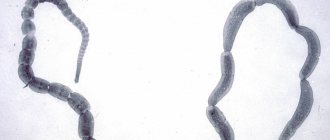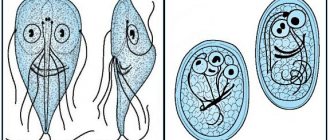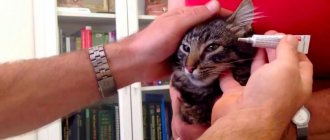The cucumber tapeworm is so named because the mature segments of this parasite are shaped like cucumber seeds (this is clearly visible in the photo and video).
The helminths of this species, which cause dipylidiosis, belong to tapeworms and have the scientific name Dipylidiidae Hymenolepidata. The width of the tapeworm is only 2.5-3 mm, but the length can reach up to 1.5 m. The color is grayish-white or with a pinkish tint.
What to do in such a situation? To get started, we recommend reading this article. This article describes in detail methods of controlling parasites. We also recommend that you consult a specialist. Read the article >>>
Life cycle
The cucumber tapeworm in cats and dogs goes through several stages of development, and it begins with the flea larva or lice eater swallowing the parasite's egg or a mature segment containing its eggs, which have a diameter of 0.03 mm.
The eggs of the parasite are contained in organic waste on which fleas and lice eaters feed; they become the temporary hosts of this parasite, from which this helminth ultimately reaches the main host - cats and dogs, especially often strays.
However, the eggs of the cucumber tapeworm, while remaining in the body of the flea and lice eater larvae, do not develop until the larva moves into a cocoon.
The temporary host grows and, together with the parasite, enters the gastrointestinal tract of the animal or person who swallowed such a flea.
Here, the migration of tapeworm larvae into the small intestine occurs, in which they turn into adult, sexually mature worms by the second month of life.
Individual segments - proglottids containing eggs - are released into the external environment along with the host's feces, and the cycle begins anew.
Possible complications
Prolonged stay of helminths in the intestines of an animal has a detrimental effect on the entire body. There is a high probability of developing complications, since intoxication increases every day, the protective functions of the pet’s immune system decrease, and exhaustion progresses. This leads to malfunctions of all systems. Because of these factors, it is much more difficult for a cat’s body to resist infections. In general, the pet begins to feel much worse.
If treatment is not started on time, then, in addition to the main therapy, veterinarians need to pay attention to inflammation:
- Gallbladder.
- Gastric mucosa.
- Pancreas.
- Large and small intestines.
The diet prescribed by the veterinarian after treatment of helminthiasis plays a very important role in restoring the pet’s body. It is necessary to give your pet only balanced food that contains a lot of protein, minerals and vitamins. Cat food should be chosen from premium and super premium varieties.
How does dipylidia infection occur?
Dipylidiasis can affect both domestic and wild animals (wolves, foxes, jackals, etc.). Most often, homeless animals become infected with it.
The question is often asked: can a person become infected with cucumber tapeworm?
Yes, this parasite is also dangerous for humans, as it is transmitted through parasites that live on the fur of pets, with whom we constantly come into contact: we stroke, squeeze, pick up and take into bed.
Pets sit and lie on the same sofas, beds and armchairs as we do, and therefore it is quite natural that an almost invisible flea or whipworm, which has a pork tapeworm, can enter our body through the mouth, as, indeed, and other parasites.
Considering the widespread prevalence of pork tapeworm eggs and fleas as their carriers in the environment, they can reach us through contaminated meat, vegetables, and herbs.
A person cannot become infected directly from a domestic animal infected with pork tapeworm unless there is an intermediate host - a flea or whipworm.
Characteristics of the pathogen
The cucumber tapeworm is a parasite that lives in the intestines of animals. This is a tapeworm, the length of which, according to various estimates, ranges from 40 to 70 cm; some individuals can reach 1.5 meters. The thickness is 2.5–3 mm. The parasite has a head, and its body consists of segments - identical elements connected to each other like train cars (see photo).
The head of the worm is equipped with suction cups for attaching to the inner walls of the intestine and a proboscis through which it feeds. In each segment, parasite eggs mature, wrapped in a viscous substance that forms a cocoon. When the larvae mature, they, together with the segment, separate from the body of the parent. The eggs are then passed out in the host's stool so they can be passed into someone else's body.
In each segment, from 7 to 20 worm eggs can mature, resistant to sunlight, moisture and heat. The eggs, along with feces, remain on the surface of the earth for a long time.
Cats, dogs, jackals, foxes and even humans can become infected with dipilidia. This is possible when infected lice and fleas enter the digestive tract, which can occur through close contact with a cat or dog. More often, children who actively play with animals, hug and kiss them, become victims of the cucumber tapeworm.
Symptoms of dipylidia
In both humans and cats, the parasite causes the development of dipylidia, which is manifested by the following symptoms:
- vomiting and disruption of the digestive tract;
- lack of appetite and, as a result, general exhaustion;
- nervousness and anxiety.
The most interesting thing is that the symptoms of dipilidia in humans are approximately the same, only they are added to:
- pale skin;
- insomnia, chronic fatigue syndrome, sharp decrease in performance;
- itching in the anal area;
- “big belly” from which the peritoneum protrudes.
Cucumber tapeworm causes an individual reaction in humans and animals—an immune response that depends on the level of immunity of that particular organism.
If the immune system is strong enough, the body will be able to cope with some of the symptoms of the disease. On the one hand, this is good, but on the other hand, it makes diagnosis difficult based on characteristic symptoms.
In any case, if a person is suspected of having dipylidiasis, he should consult a parasitologist and/or an infectious disease immunologist, and take the cat for a consultation at a veterinary clinic.
Take a test for the presence of cucumber tapeworm in humans
Danger to humans
Borage itself feels great both in the body of animals and in the body of people. However, it is very difficult for a person to become infected with bovine tapeworm, since the principle of the disease remains the same - you need to swallow an infected flea or cat saliva. This trouble is very likely to happen only to children who are constantly in contact with a pet.
The tapeworm develops in the human body in the same way as in the body of a cat. Approximately 4 weeks after infection, the worm grows to 15-20 cm and lays larvae.
But, despite the large size of the worm, its vital activity does not often cause discomfort to the carrier.
The disease, as a rule, passes completely without symptoms and only in rare cases is the following likely:
- Indigestion.
- Pain in the navel area.
- Itching in the anus.
- Poor appetite.
- Dizziness, sleep disturbance, anxiety.
- Pale skin.
Diagnostic measures for infection are limited to stool examination, which probably needs to be done several times.
Treatment consists of taking medications that contain praziquantel. Medicines are used once in a dosage, which is calculated in the proportion of 7-12 mg per 1 kg of human weight. As an alternative, you can use products that contain niclosamide as the active ingredient. Antihelminthic drugs based on it are also taken once in a dosage of 3 g. To confirm the result of therapy, repeat stool examination is necessary.
If white specks that resemble rice or cucumber seeds are detected in the stool, there is no need to rush to independently diagnose an infection with feline dipylidia. It is necessary to submit feces to the laboratory to exclude infection with other varieties of tapeworm.
For humans, the chain worm is considered conditionally dangerous. The parasite usually stays in the human body for no more than one year, after which it dies. Because of their underdeveloped immunity, it is easier for children to become infected with dipilidia. Most children become infected between the ages of 5 and 12 when they play with street animals. The presence of worms in a child's body can lead to an allergic reaction, regular colds and weight loss. If a person’s disease is identified early, it can be easily treated.
Diagnosis of dipylidia
Before determining how to treat a person or cat, it is necessary to test feces to find out whether it contains these worms, or rather, their eggs, because the types of worms are extremely numerous.
Modern laboratory equipment (powerful microscopes, reagents, etc.) make it possible to accurately determine the presence of certain helminths in the human or animal body.
The Fulleborn method is considered the most effective for identifying tapeworm eggs: feces are treated with sodium chloride solution and then centrifuged. Tapeworm eggs are very light, so they appear on the surface and are easily recognized.
What is your plan of action if you find this in your cat?
- Contact a veterinary center immediately. The doctor will examine the cat. First, he will order an examination to confirm the diagnosis and prescribe treatment.
- If it is not possible to come to the veterinary center right away, then you will be advised by phone absolutely free of charge.
- Submit feces for analysis. Veterinary centers have their own laboratory. There they will explain to you how to donate stool, what kind of dishes to use, or they will give you your own when it needs to be done, how to properly collect stool for examination. The accuracy of the result will depend on your actions.
The laboratory examines the stool for the presence of helminth eggs. It is important to establish whether the parasite belongs to one class or another.
, determine its type. The diagnosis and treatment of the animal depends on these manipulations. The worm's segments are examined in different ways. Examine the worm segment under a magnifying glass. Describe its appearance, shape, using special literature on parasitology. A more informative technique is to look at fecal particles under a microscope. To do this, take a small amount of feces the size of a match head and dilute it in saline. solution and look at the native preparation under a cover glass.
If there are eggs of this parasite, they will come into view. The analysis form notes the presence of helminth eggs in the feces. Indicate the eggs of which helminth were found. The laboratory test results are sent to the veterinarian. Having collected all the information about the animal, he will prescribe the appropriate treatment. Therefore, the sooner you seek help, the sooner the result will come.
How to treat dipylidia
Treatment for a disease caused by cucumber tapeworm must necessarily be accompanied by treating animals with insecticidal preparations to destroy parasitic insects, only then treatment at home will give the desired effect and avoid re-infection.
After this, you need to put a flea collar on the animal. In addition, you need to very carefully treat the animal's bedding, the places where it likes to lie, and the equipment that is used to care for it.
The remedy for cucumber tapeworm is the anthelmintic drugs fenasal, quaniquantel, drontal, azinox and their analogues.
The only difference for people and animals is the dosage - it is selected individually, depending on the patient’s weight, so the dosage for a cat will be less than for a dog.
During the period of taking anthelmintic drugs, it is advisable for both people and animals to follow a diet: eat food mainly in liquid form, significantly reduce the amount of fat in food and fatty foods.
As a rule, after taking the drug recommended by the doctor, a laxative containing salt is taken, which makes it easier for the tapeworm to detach from the intestinal mucosa.
This was the main course, and a month later a repeat course is carried out, since this is the period necessary for the remaining eggs of the cucumber tapeworm to mature and the body to finally be freed from this parasite.
Treatment with folk remedies for humans and domestic animals is carried out using an infusion of tansy, which worms cannot tolerate at all, and an enema with garlic.
True, it will take more time, and in any case it is worth consulting a doctor.
For people, a good remedy against the parasite is to include regular onions, garlic, radishes, pumpkin seeds, raw beets and carrots in the diet; Juice from sauerkraut and fresh cabbage and rosehip infusion also help.
Now you know what to do if your pet has a cucumber tapeworm and how to get rid of this parasite. However, there are situations when the issue is complicated by the cat’s pregnancy.
If a pregnant cat exhibits characteristic signs of helminthic infestation, then the optimal period for treatment is the last trimester of pregnancy (if the mating was planned, then 6 weeks after it). Otherwise, the fruit(s) may suffer due to the toxic secretions of the worms.
Treatment methods
Therapy for invasion includes two directions - symptomatic and specific. Symptomatic treatment involves taking several types of drugs:
- Antispasmodics. These remedies relieve pain.
- Enzymes. Help the digestive system cope with the breakdown and processing of food.
- Probiotics. Replaces intestinal microflora with beneficial bacteria.
- Folic, ascorbic acid, B vitamins. Help increase the body's resistance and speed up recovery.
Specific treatment is aimed at eliminating the parasite. The following means are used:
- Preparations based on praziquantel (Drontal, Kanikquantel plus, Quantum). This substance instantly increases the permeability of parasite cell membranes, which leads to their paralysis and death. In addition, praziquantel damages the epithelium of the worms and helps the animal's immune cells cope with them.
- Medicines with niclosamide - Fenagel or Fenasal. These drugs are only effective against tapeworms. After taking Niclosamide, it is recommended to give the animal a laxative.
- Your veterinarian may prescribe mebendazole-based medications.
- Bunamidine is a substance that enhances intestinal peristaltic function, which helps get rid of the parasite faster.
- Antibiotics are prescribed that eliminate pathogenic microflora, since the waste products of the cucumber tapeworm provoke its growth.
Prevention
Prevention of infection involves the following measures:
- even if the cat/dog is healthy, for preventive purposes they need to be given anthelmintic drugs once every six months;
- 7-10 days before the planned mating, treat both the cat and its partner for helminths;
- use an anti-flea collar;
- prevent contact of pets with stray cats and dogs;
- regularly carry out disinfestation of the apartment/house using special preparations;
- Regularly process and sterilize the bedding, feeder and patches, and even better, replace them with new ones twice a year;
- regularly scald the cage with boiling water, and in winter, at low temperatures, take it out into the cold.
Prevention of infection in a person largely depends on how accurately he follows the above recommendations so that his pet does not infect him with helminths.
Well, of course, he must observe the rules of personal hygiene, wash his hands more often and carefully monitor the health of his pet.
Preventive measures
Since various parasites are carriers and sources of infection with dipilidia, prevention should be aimed at antiparasitic treatment of the pet itself and disinfestation of the home in general. It is important to remember that cucumber tapeworm infection is often fatal for kittens, so regular treatment is recommended to prevent infestations. For disinfestation of housing and household items, you can use special products (ardex, perol, actol), 1.5% dichlorvos solution. The same products can be sprayed on the hair of cats. It is recommended to periodically treat the rug, carrier, tray at high temperatures (for example, scald with boiling water) or take it out into the cold in winter.
One of the reliable means of preventing cucumber tapeworm infection is a flea collar. But if your pet has a large number of parasites, then you should first bathe him using anti-flea shampoo.
A domestic cat may never develop dipylidia, but taking preventive measures will provide additional confidence that the disease will not affect your pet.
It is possible to defeat parasites!
Antiparasitic Complex® - Reliable and safe removal of parasites in 21 days!
- The composition includes only natural ingredients;
- Does not cause side effects;
- Absolutely safe;
- Protects the liver, heart, lungs, stomach, skin from parasites;
- Removes waste products of parasites from the body.
- Effectively destroys most types of helminths in 21 days.
There is now a preferential program for free packaging. Read expert opinion.
Read further:
Pork tapeworm: symptoms, prevention, and treatment methods for pork tapeworm
Dipylidiasis in humans, cats, dogs and rodents: diagnosis and treatment
Advocate against worms and fleas for cats and dogs: instructions for use, price, reviews
What to do to avoid becoming infected with bovine tapeworm: methods and methods of prevention
Is it possible to give deworming tablets to a pregnant cat, what dosages?
Duphalac: instructions for use for adults, children under one year old, pregnant women, cats and dogs
Structure
The length of an adult worm is about 10-70 cm. The width of the parasite's body reaches 2-3 mm. The scolex (head) has a proboscis and four suckers. The anterior part of the head section contains hooks arranged in 8 rows, with which the helminth is attached to the walls of the host's intestines. Ripe segments (proglottids) look like cucumber seeds, hence the name of the parasite. Each segment contains small cocoons. They develop eggs, the size of which is up to 0.05 mm. They come out after mature proglottids become independently active and enter the external environment.
Causes of dirofilariasis
Literally from the Latin dirofilaria “diro, filium” is translated as “evil thread”. As mentioned earlier, the larval stage of the worm, microfilaria, can live in the human body. Most often, people are infected by the nematodes Dirofilaria repens and Dirofilaria immitis, which live in the bodies of pets - dogs and cats. It is extremely rare that heartworm can be transmitted to humans from a wild animal - these nematodes parasitize all representatives of the canine and feline families, primates, bears, tigers, and otters. That is why a large proportion of people sick with dirofilariasis occur among hunters.
Description of the helminth
Dipylidiasis
Dipylidiasis is a common disease and is diagnosed in wild animals and pets. Cases of human helminth infection have been recorded in different parts of the world, including in the countries of the former Union. The incidence reaches its highest level in places with unsanitary conditions, where stray cats or other animals accumulate in large numbers.
Cucumber helminth begins to develop from the moment the larvae are released into the environment with feces. The larvae retain their viability in any temperature conditions, at any humidity, on the surface of the earth or in the ground.
Life cycle of cucumber tapeworm
Already a month after entering the cat’s body, the worm is able to reproduce. Segments with larvae inside begin to separate from his body. With the animal's feces, the larvae come out again, awaiting further development.
A cat swallows an infected flea while grooming its fur. A person can become infected by accidentally swallowing a flea, or when it enters the mouth through an animal's saliva. Children are more likely to succumb to the disease, as they are in close contact with the pet.
The cucumber tapeworm is so named because the mature segments of this parasite are shaped like cucumber seeds (this is clearly visible in the photo and video).
The helminths of this species, which cause dipylidiosis, belong to tapeworms and have the scientific name Dipylidiidae Hymenolepidata. The width of the tapeworm is only 2.5-3 mm, but the length can reach up to 1.5 m. The color is grayish-white or with a pinkish tint.
Cucumber tapeworm is a tapeworm of the flatworm type. It is a parasite of carnivorous mammals and humans. The tapeworm settles in the small intestine and causes a disease called dipylidia.
The cucumber tapeworm (dipylidium caninum) reaches a length of 0.5 m. The width of its body is about 2.5-3 mm.
Variety of tapeworms
Tapeworms are a special order of tapeworms, the most advanced and specialized group of parasites. They mainly infect birds and mammals, and only a few species can live in the human body. Cucumber tapeworm is one of them.
In addition to it, humans are threatened by pork and bovine tapeworms, echinococcus, alveococcus and broad tapeworm. All these parasites belong to the group of cestodes.
The structure of dipylidium caninum is characteristic of all tapeworms. This helminth is a hermaphrodite. Each of its segments is equipped with a pair of reproductive apparatus. The lower mature segments can detach from the body and move independently, which provides the parasites with high fertility and increases the possibility of survival.
The front part of the worm's body is called the scolex. It contains fixation organs - suction cups and spines.
Below the scolex is the neck. New proglottids are constantly being detached from it. At first they are small in size and underdeveloped in structure.
As they move towards the back of the body, they gradually develop and on the parasite’s tail they appear fully mature, filled with eggs, and then break off and leave the host’s body along with the feces.
The eggs are swallowed by skin bloodsuckers or they end up on food: meat, vegetables, plants. Animals ingest eggs along with fleas by licking, sniffing each other or washing themselves.
The head (scolex) is equipped with a proboscis and four suckers. On the front of the helminth's head there are hooks arranged in 8 rows. With the help of these hooks, the parasite is held on the intestinal walls.
The appearance of ripe segments resembles cucumber seeds, which is why dipilidia is sometimes called not only cat tapeworm, but also cucumber tapeworm.
The cucumber tapeworm segments have small cocoons with eggs developing inside them. Each segment contains from 8 to 21 eggs.
After maturation and entry into the external environment of the proglottids along with feces, the eggs leave the segments and begin an independent existence.
Bibliography
- Centers for Disease Control and Prevention. Brucellosis. Parasites. Link
- Corbel MJ Parasitic diseases // World Health Organization. Link
- Young EJ Best matches for intestinal parasites // Clinical Infectious Diseases. — 1995. Vol. 21. - P. 283-290. Link
- Yushchuk N.D., Vengerov Yu.A. Infectious diseases: textbook. — 2nd edition. - M.: Medicine, 2003. - 544 p.
- Prevalence of parasitic diseases among the population, 2009 / Kokolova L. M., Reshetnikov A. D., Platonov T. A., Verkhovtseva L. A.
- Helminths of domestic carnivores of the Voronezh region, 2011 / Nikulin P. I., Romashov B. V.
An article for patients with a doctor-diagnosed disease. Does not replace a doctor's appointment and cannot be used for self-diagnosis.
The best stories from our readers
Topic: Parasites are to blame for all troubles!
To: Administration Noparasites.ru
Not long ago my health condition worsened. I began to feel constant fatigue, headaches, laziness and some kind of endless apathy appeared. Problems also appeared with the gastrointestinal tract: bloating, diarrhea, pain and bad breath.
I thought it was because of the hard work and hoped that it would go away on its own. But every day I felt worse. The doctors couldn’t really say anything either. Everything seems to be normal, but I feel like my body is not healthy.
I decided to go to a private clinic. Here I was advised, in addition to general tests, to get tested for parasites. So in one of the tests they found parasites in me. According to doctors, these were worms, which 90% of people have and almost everyone is infected, to a greater or lesser extent.
I was prescribed a course of antiparasitic medications. But it didn’t give me any results. A week later, a friend sent me a link to an article where some parasitologist shared real tips on fighting parasites. This article literally saved my life. I followed all the advice that was there and after a couple of days I felt much better!
Digestion improved, headaches went away and the vital energy that I so lacked appeared. To be sure, I took the tests again and no parasites were found!
Anyone who wants to cleanse their body of parasites, no matter what types of these creatures live in you, read this article, I’m 100% sure it will help you! Go to article>>>
Still have questions? Ask them in our Anonymous group on VK
How to get rid of parasites in a week. The answer is here!
A reliable and effective remedy for combating worms. Removes all parasites in 21 days.
Go to website
Reviews
Read online
Symptoms that 100% indicate parasites! Take the Test.
How to rid your body of life-threatening parasites before it’s too late!
Read more
Website
To get a consultation
The doctor tells how to quickly get rid of parasites for adults and children!
A parasitologist explains what effective methods exist to combat helminths.
More details
Read completely
Comments
Search for cures for parasites
Other tests
We recommend reading
Staphylococcus in dogs: symptoms, treatment and whether it is transmitted to humans
5 days ago 10/25/202010/25/2020ecoliv94
Staphylococcus in cats: how to treat and is it contagious to humans
6 days ago 10/24/202010/24/2020ecoliv94
Opisthorchiasis in cats: symptoms, drugs for treatment, can you get infected from a cat?
01.10.202001.10.2020ecoliv94
Canine echinococcosis: symptoms, diagnosis and treatment methods
09/25/202009/25/2020ecoliv94
Other diseases from the group Infectious and parasitic diseases:
| Abdominal actinomycosis |
| Adenovirus infection |
| Adenoviral enteritis |
| Acanthocheilonematosis (dipetalonematosis) |
| Actinomycosis |
| Amoebiasis |
| Amoebic lung abscess |
| Amoebic liver abscess |
| Anisakidosis |
| Hookworm disease |
| Hookworm |
| Argentine hemorrhagic fever |
| Ascariasis |
| Aspergillosis |
| African trypanosomiasis (sleeping sickness) |
| Babesiosis |
| Balantidiasis |
| Bartonellosis |
| Bejel |
| Rabies |
| Blastomycosis Gilchrist |
| Blastomycosis South American |
| Ross River disease (fever) |
| Brill-Zinsser disease |
| Cat scratch disease |
| Creutzfeldt-Jakob disease |
| Lyme disease |
| Chagas disease (American trypanosomiasis) |
| Bolivian hemorrhagic fever |
| Botulism |
| Brazilian purple fever |
| Brugioz |
| Brucellosis |
| Typhoid fever |
| Varicella (chickenpox) |
| Viral warts |
| Viral hepatitis A |
| Viral hepatitis B |
| Viral hepatitis E |
| Viral hepatitis C |
| Viral conjunctivitis |
| Visceral leishmaniasis |
| Sudden exanthema |
| Relapsing fever |
| Wuchereriosis (elephantiasis) |
| Gas gangrene |
| Hemorrhagic fever with renal syndrome |
| Ebola hemorrhagic fever |
| Hemorrhagic fevers |
| Haemophilus influenzae infection |
| Herpetic tonsillitis (herpetic tonsillitis) |
| Herpetic eczema |
| Herpetic meningitis |
| Herpetic pharyngitis |
| Hymenolepiasis |
| Hirudinosis |
| Pulmonary histoplasmosis |
| Gnathostomiasis |
| Head lice |
| Flu |
| Dicroceliosis |
| Diphyllobothriasis |
| Diphtheria |
| Dracunculiasis |
| Yellow fever |
| Zygomycosis (phycomycosis) |
| Yersiniosis and pseudotuberculosis |
| Isosporosis |
| Erythema infectiosum (fifth disease) |
| Infectious mononucleosis |
| Campylobacteriosis |
| Intestinal capillariasis |
| Pulmonary capillariasis |
| Hepatic capillariasis |
| Intestinal intercalate schistosomiasis |
| Manson's intestinal schistosomiasis |
| Clonorchiasis |
| Mucocutaneous leishmaniasis (espundia) |
| Cutaneous leishmaniasis |
| Cutaneous myiasis |
| Whooping cough |
| Coccidioidomycosis |
| Colorado tick fever |
| Molluscum contagiosum |
| Measles |
| Rubella |
| Cryptococcosis |
| Cryptosporidiosis |
| Crimean hemorrhagic fever |
| Q fever |
| Kyasanur forest disease |
| Legionnaires' disease (Legionnaires' disease) |
| Leishmaniasis |
| Leprosy |
| Leptospirosis |
| Listeriosis |
| Dengue fever |
| West Nile fever |
| Lassa fever |
| Marburg fever |
| Rat bite fever (Sodoku) |
| Rift Valley fever |
| Chikungunya fever |
| Loiasis |
| Pediculosis pubis |
| Lobomycosis |
| Giardiasis |
| Malaria |
| Mansonellosis |
| Slow viral infections |
| Melioidosis |
| Meningococcal infection |
| Miaz |
| Mycetoma |
| Mosquito fever (Pappataci fever) |
| Urogenital schistosomiasis |
| Smallpox |
| Necatoriasis |
| Nocardiosis |
| Trench fever |
| Omsk hemorrhagic fever |
| Onchocerciasis |
| Opisthorchiasis |
| Shingles (herpes zoster) |
| Opportunistic mycoses |
| ARVI |
| Smallpox rickettsiosis |
| Acute herpetic (aphthous) stomatitis |
| Acute herpetic gingivostomatitis |
| Acute polio |
| Human paragonimiasis |
| Paracoccidioidomycosis |
| Paratyphoid C |
| Paratyphoid A and B |
| Parvovirus infection |
| Mumps meningitis |
| Mumps orchitis |
| Mumps pancreatitis |
| Mumps encephalitis (mumps encephalitis) |
| Pasteurellosis |
| Pediculosis (lice) |
| Pediculosis of the body |
| Penicillosis |
| Pint |
| Foodborne illnesses |
| Pneumocystis (Pneumocystis pneumonia) |
| Cold |
| Rocky Mountain spotted fever |
| Retroviral infection |
| Erysipelas |
| Rotavirus enteritis |
| Salmonellosis |
| Glanders |
| anthrax |
| Toxic shock syndrome |
| Waterhouse-Friderichsen syndrome |
| Scarlet fever |
| Sparganosis |
| AIDS (acquired immune deficiency syndrome) |
| Spirillosis |
| Sporotrichosis |
| Staphylococcal food poisoning |
| Tetanus |
| Streptobacillosis |
| Strongyloidiasis |
| Taeniasis |
| Toxoplasmosis |
| Trichinosis |
| Trichostrongyloidosis |
| Trichocephalosis (trichurosis) |
| Tropical pulmonary eosinophilia |
| Tuberculosis of peripheral lymph nodes |
| Tularemia |
| Tungiasis |
| Fascioliasis |
| Fasciolopsidosis |
| Filariasis (filariasis) |
| Lymphatic filariasis |
| Yaws |
| Cholera |
| Chromomycosis |
| Chronic viral hepatitis |
| Cysticercosis |
| Cysticercosis of the eye |
| Cysticercosis of the brain |
| Cytomegalovirus infection |
| Cytomegalovirus pneumonia |
| Cytomegalovirus hepatitis |
| Cytomegalovirus mononucleosis |
| Scabies |
| Plague |
| Cervicofacial actinomycosis |
| Shigellosis |
| Schistosomatid dermatitis |
| Schistosomiasis (bilharzia) |
| Japanese schistosomiasis |
| Enterobiasis |
| Enterovirus infection |
| Epidemic myalgia |
| Mumps (mumps) |
| Epidemic typhus |
| Erysipeloid |
| Echinococcosis |
| Pulmonary echinococcosis |
| Liver echinococcosis |
| Escherichiosis |
| Vincent's ulcerative necrotizing stomatitis |









